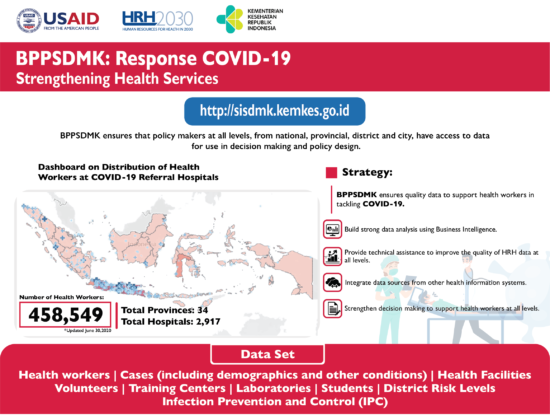
29 Jul Ready to Respond: Indonesia’s HRH Data System Supports COVID-19 Decision Making
Click here to enlarge the infographic.
Investments in Indonesia’s health workforce information systems, including enhancing its core platform to make health workforce data more accessible and improving data analytics, are enabling a strategic response to the COVID-19 pandemic, while maintaining essential services across many levels of the health system.
In South Sulawesi province, which has the third-highest prevalence rate of COVID-19 in the country, facilities are relying on the health workforce data from the national health workforce information system to effectively deploy health workers, said the province’s head of human resources for health, Fithriyani Komarudin.
“The Ministry of Health, through the Board of Human Resources for Health Empowerment and Development, has deployed approximately 300 additional health workers from various cadres to care for COVID-19 patients,” Ms. Komarudin said. She identified health workers from the military, police, recent graduates from Polytechnic schools, and others as among those who are being mobilized to respond to the pandemic.
Indonesia, with a population of 273 million people and 1.2 million health workers, had 88,214 cases of COVID-19 as of July 20.
According to Ester Pabaru, an epidemiologist with the District Health Office (DHO) in North Kalimantan, “The human resources for health data makes it easy for the DHO to maximize the distribution of health workers at COVID-19 district level task force, seconded at the COVID-19 referral hospital. It’s also done the same for those where we’re quarantining [patients] without symptoms.”
At the provincial level in Aceh, HRH Data Officer Erlinda (who goes by only one name) agreed, saying, “The HRH data is used to calculate the number of health workers in health facilities, personal protective equipment (PPE) needs, and incentives.”
In addition to the COVID-19 response, stakeholders have been using the health workforce data to maintain essential services at the facility level. Hasmawati, a midwife from Public Hospital Tarakan, in Kaimantan Utara, which has seen 125 deliveries since March 2020 when the COVID-19 pandemic reached Indonesia, uses health workforce data to continuously recalculate health workforce needs for the hospital, based on the workload of the facility.
At the national level, health workforce data and analytics from the human resource information system platform are being used by the national level COVID-19 taskforce as part of the daily situational reports. These dashboards allow decision makers that are leading the COVID-19 response in the country with access to critical information on where health workers are throughout the country as compared to COVID-19 positive cases, district risk levels and availability of infection prevention control material.
For the last two years, through the support of USAID, HRH2030 has been working with the Ministry of Health Board of Human Resources for Health Empowerment and Development (BPPSDMK in Indonesia) to improve the availability and use of quality health workforce data. Together with a variety of government stakeholders, the team has strengthened the capacity and functionality of Indonesia’s human resource information system, known as SI-SDMK, building a strong ecosystem of health workforce information systems, and developing a strong data analytics platform. By late 2019—before COVID-19 arrived in country—the users of SI-SDMK and other key players in the health system had been trained to develop data visualizations that provided real-time answers to key health sector questions, thus translating data into evidence-driven actionable answers for decision-makers.
Dr. Mawari Edy, the Director of the Data and Information Unit of the BPPSDMK noted that these investments are paying dividends not only for the current pandemic but also for future health emergencies.
“The BPPSDMK COVID-19 dashboard is currently being used by the Task Force Team to make national decisions and assist in the implementation of the COVID-19 response program at the Ministry of Health. It is also helping the Ministry of Health become more resilient and experienced in using better data usage and pandemic management strategies in the future.” As Indonesia’s health system continues to use their new data capabilities to respond to COVID-19, it is also helping the Ministry of Health become more resilient and gain the experience needed in using data to be better prepared for future shocks.





